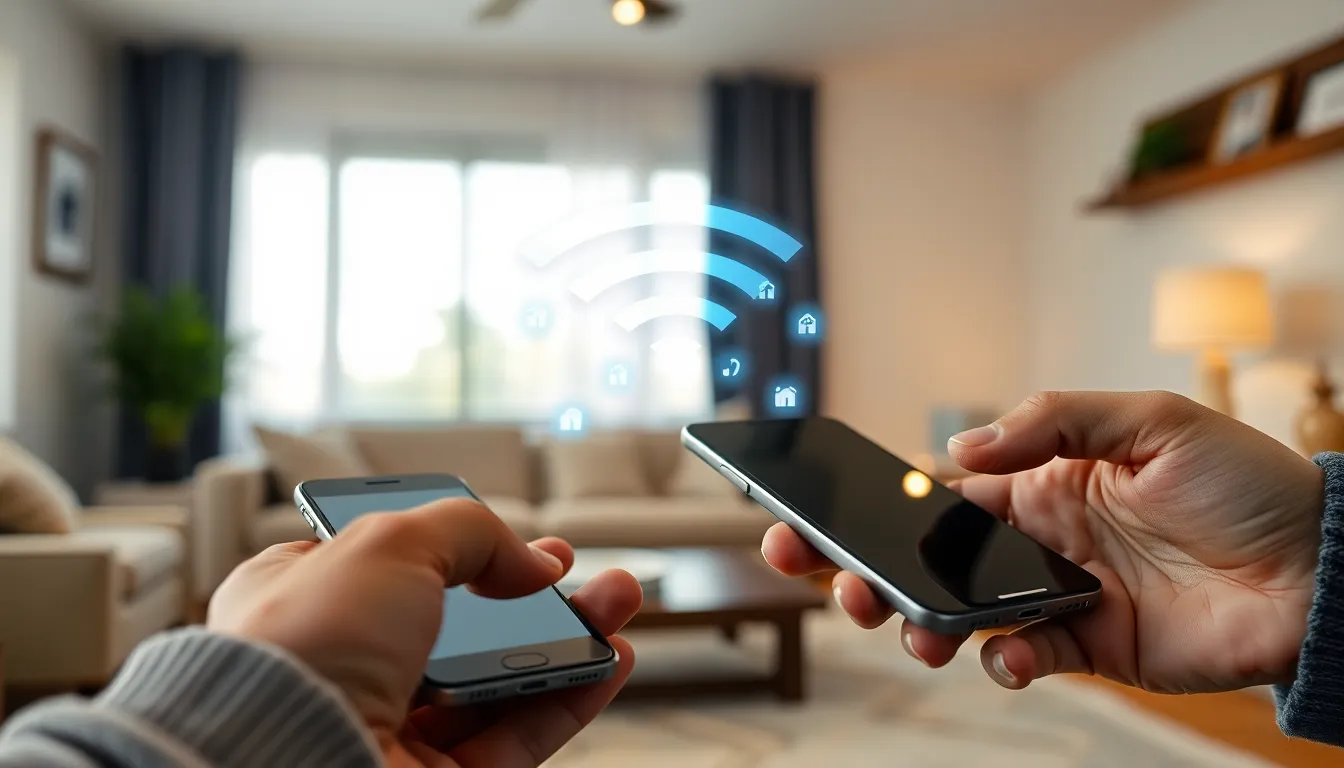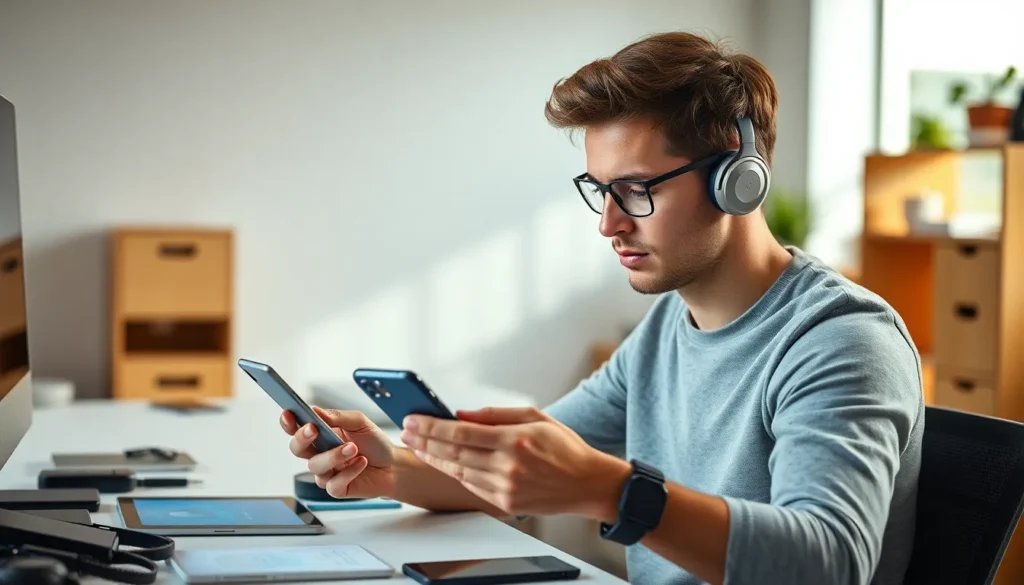In a world where gadgets are practically an extension of ourselves, the device pairing process can feel like a high-stakes game of hide and seek. Whether it’s connecting your phone to that snazzy new pair of headphones or syncing your smartwatch to your fitness app, getting everything to play nice can be a bit of a dance. And let’s face it, nobody wants to be the person fumbling with buttons while their friends enjoy the latest playlist.
Table of Contents
ToggleOverview Of Device Pairing Process
Device pairing involves connecting two electronic devices to work together seamlessly. This often requires enabling Bluetooth or Wi-Fi on both devices, ensuring they can discover and communicate with each other. Users frequently encounter a pairing code or prompt asking for confirmation of the connection.
Procedure starts with identifying the devices needing connection. For example, smartwatches pair with smartphones to synchronize notifications and apps. Headphones connect to tablets to provide an enhanced listening experience. Following identification, access the settings on both devices to enable their respective pairing modes.
Discoverability plays a crucial role in the pairing process. One device needs to be in a mode that allows it to be found by others. Users typically see a list of available devices once both are in pairing mode. Selecting the correct device from the list is vital for successful connection.
Authentication often follows discovery. Many devices use pairing codes or temporary passkeys, which users must enter to establish a secure link. Security features prevent unauthorized access and ensure a safe connection environment.
Common complications arise during the process. Sometimes devices fail to connect due to outdated software. Checking for software updates can resolve many of these issues. Resetting devices to factory settings may also fix persistent pairing problems.
Device connections can enhance functionality significantly. Smart appliances, fitness trackers, and gaming controllers benefit from successful pairings, improving user experience. Understanding the steps and challenges in device pairing helps users navigate technology more confidently.
Types Of Device Pairing

Device pairing occurs in several forms, each tailored for specific connectivity needs. Understanding the differences helps users choose the best method for their devices.
Bluetooth Pairing
Bluetooth pairing enables short-range wireless communication between devices, typically within a range of 30 feet. This method connects devices like smartphones and headphones effortlessly. Users start by enabling Bluetooth settings on both devices to initiate discovery. Selecting the appropriate device from the list follows this. Often, users must enter a passkey for authentication. Most devices support Bluetooth pairing, making it a versatile choice for many gadgets. Compatibility remains important, so ensuring both devices have Bluetooth capabilities is essential.
Wi-Fi Direct Pairing
Wi-Fi Direct pairing allows devices to connect over a Wi-Fi network without requiring a router. This method provides faster data transfer rates compared to Bluetooth. Devices like smart TVs and smartphones commonly utilize this connection type for streaming content. Activating Wi-Fi Direct settings prompts devices to find one another. Users then select the target device for connection. Authentication may involve entering a password. Many modern devices now support Wi-Fi Direct, enhancing convenience for users sharing files or streaming media. This pairing option proves particularly useful where large files need quick transfer.
Steps In The Device Pairing Process
Device pairing involves multiple straightforward steps. Each step plays a crucial role in ensuring devices connect seamlessly.
Initial Setup
Enabling the pairing mode on both devices marks the first step. This action makes them discoverable. Users often navigate to the settings menu where Bluetooth or Wi-Fi Direct options reside. Selecting the appropriate mode activates the connection protocol. Next, identifying the devices appears as a key action; users browse through a list of available devices. Choosing the intended device for connection requires attention, as multiple devices may appear. Once selected, confirmation typically prompts users to enter a passkey or code, establishing security for the connection.
Pairing Confirmation
Receiving pairing confirmation signifies a successful connection. Devices usually display a notification indicating they are now connected. Users can test the connection immediately, often by playing audio or accessing shared files. In cases where devices fail to pair, checking settings becomes important. Ensuring visibility and pairing modes remain active can resolve many issues. Sometimes, restarting the devices clears minor glitches, leading to successful connections. Maintaining updated software throughout aids in successful pairings, as outdated software may cause compatibility issues.
Challenges In Device Pairing
Device pairing often presents several challenges that users encounter frequently. Understanding these barriers helps improve the overall user experience.
Connectivity Issues
Connectivity issues often arise during the pairing process. Signal interference can stem from physical barriers like walls or other electronic devices operating on similar frequencies. Bluetooth connections, for instance, require devices to be within approximately 30 feet of one another for optimal function. Wi-Fi Direct connections, while faster, depend on the quality of the Wi-Fi signal, which can fluctuate. Users might also face problems if one device is out of range or has Bluetooth turned off. Checking settings for visibility can resolve many of these connectivity hurdles. Ensuring devices are compatible with the required pairing method enhances the likelihood of success.
Compatibility Problems
Compatibility problems hinder many users from establishing successful connections. Each device has specific requirements for pairing, such as software versions and supported protocols. A smartphone might support Bluetooth 5.0, while an older pair of headphones only works with Bluetooth 4.0. Outdated firmware can prevent devices from recognizing each other, which typically necessitates software updates. Additionally, brand restrictions may limit compatibility; certain devices are designed to connect only within specific product ecosystems. Verifying device compatibility before attempting to pair can streamline the process and reduce frustration.
Best Practices For Successful Pairing
Ensuring both devices are charged before initiating the pairing process can prevent interruptions. Users must activate pairing mode on each device to make them discoverable. Selecting the intended device from the available options is crucial for establishing a connection.
Checking software updates is essential, as outdated versions can lead to compatibility problems. Restarting devices often clears minor glitches that may hinder successful pairing. Creating a clear line of sight between the devices minimizes signal interference that can disrupt connections.
Every user should verify that devices support the required pairing method, whether Bluetooth or Wi-Fi Direct. When using Bluetooth, entering the correct passkey ensures secure authentication. In Wi-Fi Direct connections, enabling the necessary settings facilitates faster data transfer.
Testing the connection immediately after pairing helps identify issues early. Confirmations during the pairing process indicate a successful connection, allowing for adjustments if needed. Users often benefit from consulting user manuals or online guides for specific instructions related to their devices.
Establishing a consistent pairing routine alleviates frustration during frequent connections. Familiarity with the pairing steps promotes confidence when users connect multiple devices, whether headphones and smartphones or smartwatches and tablets. Adhering to these practices enhances the overall experience and functionality of connected devices.
Navigating the device pairing process doesn’t have to be a daunting task. By understanding the steps and challenges involved users can enhance their connectivity experience significantly. From enabling pairing modes to ensuring compatibility and maintaining updated software these practices pave the way for seamless connections.
Embracing best practices not only boosts confidence but also minimizes frustration when connecting multiple devices. As technology continues to evolve staying informed about the latest pairing methods and troubleshooting tips can make all the difference. With the right approach users can enjoy the full functionality of their gadgets while effortlessly connecting with their devices.






